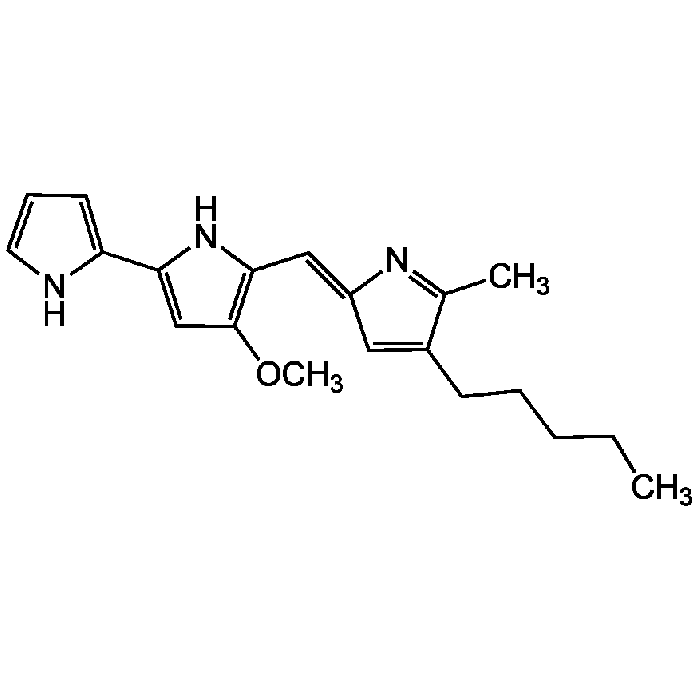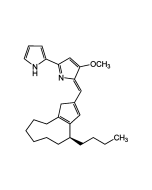Cookie Policy: This site uses cookies to improve your experience. You can find out more about our use of cookies in our Privacy Policy. By continuing to browse this site you agree to our use of cookies.
AdipoGen Life Sciences
Prodigiosin
As low as
90
CHF
CHF 90.00
In stock
Only %1 left
AG-CN2-0105-C250250 µgCHF 90.00
AG-CN2-0105-M0011 mgCHF 270.00

| Product Details | |
|---|---|
| Synonyms | NSC 47147; BRN 4526727 |
| Product Type | Chemical |
| Properties | |
| Formula |
C20H25N3O |
| MW | 323.4 |
| Merck Index | 14: 7767 |
| CAS | 82-89-3 |
| Source/Host Chemicals | Isolated from γ-proteobacterium strain MS-02-063. |
| Purity Chemicals | ≥95% (HPLC) |
| Appearance | Dark red solid. |
| Solubility | Soluble in methanol, ethanol, chloroform, ethyl acetate, hexane, acetone or acetonitrile. Insoluble in water. |
| InChi Key | SZXDNGVQRDTJSD-FOWTUZBSSA-N |
| Smiles | CCCCCC1=C\C(=C/C2=C(OC)C=C(N2)C2=CC=CN2)N=C1C |
| Shipping and Handling | |
| Shipping | AMBIENT |
| Short Term Storage | +4°C |
| Long Term Storage | -20°C |
| Handling Advice | Protect from light. |
| Use/Stability | Stable for at least 3 years after receipt when stored at -20°C. |
| Documents | |
| MSDS |
 Download PDF Download PDF |
| Product Specification Sheet | |
| Datasheet |
 Download PDF Download PDF |
Description
- Red-pigmented antibiotic [1].
- Antimalarial [2, 13].
- Immunosuppressive [3, 7, 11, 12].
- Apoptosis inducer [4-6, 15].
- Cytotoxic. Induces phosphorylation of p38-MAPK [8].
- Antimetastatic. Tumor invasion inhibitor [9].
- Induces p21WAF1/CIP1 expression [10].
- Anticancer compound [11, 12, 15].
- gp91(phox) and iNOS expression inhibitor [14].
- mTORC1 and mTORC2 complex inhibitor [16].
- Down-regulates SKP2 to induce p27(KIP1) stabilization [17].
- Blocking autophagosome-lysosome fusion [19].
Product References
- The Antibiotic Activity of Violacein, Prodigiosin, and Phthiocol: H.C. Lichstein & V.F. Van De Sand; J. Bacteriol. 52, 145 (1946)
- Antimalarial activity of prodigiosin: A.J. Castro; Nature 213, 903 (1967)
- T-cell specific immunosuppression by prodigiosin isolated from Serratia marcescens: S.B. Han, et al.; Int. J. Immunopharmacol. 20, 1 (1998)
- Prodigiosin from the supernatant of Serratia marcescens induces apoptosis in haematopoietic cancer cell lines: B. Montaner, et al.; Br. J. Pharmacol. 131, 585 (2000)
- Prodigiosin-induced apoptosis in human colon cancer cells: B. Montaner & R. Perez-Tomas; Life Sci. 68, 2025 (2001)
- Prodigiosin induces cell death and morphological changes indicative of apoptosis in gastric cancer cell line HGT-1: C. Diaz-Ruiz, et al.; Histol. Histopathol. 16, 415 (2001)
- Prodigiosin blocks T cell activation by inhibiting interleukin-2Ralpha expression and delays progression of autoimmune diabetes and collagen-induced arthritis: S.B. Han, et al.; JPET 299, 415 (2001)
- The cytotoxic prodigiosin induces phosphorylation of p38-MAPK but not of SAPK/JNK: B. Montaner & R. Perez-Tomas; Toxicol. Lett. 129, 93 (2002)
- Antimetastatic effect of prodigiosin through inhibition of tumor invasion: J. Zhang, et al.; Biochem. Pharmacol. 69, 407 (2005)
- The anticancer agent prodigiosin induces p21WAF1/CIP1 expression via transforming growth factor-beta receptor pathway: V. Soto-Cerrato, et al.; Biochem. Pharmacol. 74, 1340 (2007)
- Prodigiosins as anti cancer agents: living upto their name: R. Pandey, et al.; Curr. Pharm. Des. 15, 732 (2009)
- New insights on the antitumoral properties of prodiginines: R. Perez-Tomas & M. Vinas; Curr. Med. Chem. 17, 2222 (2010)
- Prodigiosin produced by Serratia marcescens NMCC46 as a mosquito larvicidal agent against Aedes aegypti and Anopheles stephensi: C.D. Patil, et al.; Parasitol. Res. 109, 1179 (2011)
- Prodigiosin inhibits gp91(phox) and iNOS expression to protect mice against the oxidative/nitrosative brain injury induced by hypoxia-ischemia: C.C. Chang, et al.; Toxicol. Appl. Pharmacol. 257, 137 (2011)
- Prodigiosin, the red pigment of Serratia marcescens, shows cytotoxic effects and apoptosis induction in HT-29 and T47D cancer cell lines: D. Dalili, et al; Nat. Prod. Res. 26, 2078 (2011)
- Identification of dual mTORC1 and mTORC2 inhibitors in melanoma cells: prodigiosin vs. obatoclax: M. Espona-Fiedler, et al.; Biochem. Pharmacol. 83, 489 (2012)
- Prodigiosin down-regulates SKP2 to induce p27(KIP1) stabilization and antiproliferation in human lung adenocarcinoma cells: H.Y. Hsieh, et al.; Br. J. Pharmacol. 166, 2095 (2012)
- Sensitivity of Bacillus oleronius, a bacterium that is associated with rosacea, to prodigiosin: M.V. Sayger, et al.; Science Matters (2020)
- Prodigiosin impairs autophagosome-lysosome fusion that sensitizes colorectal cancer cells to 5-fluorouracil-induced cell death: C. Zhao, et al.; Cancer Lett. 481, 15 (2020)








